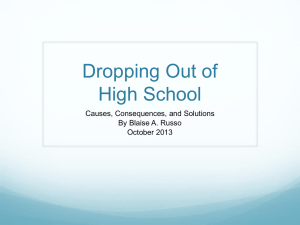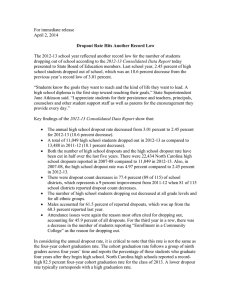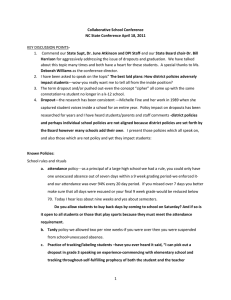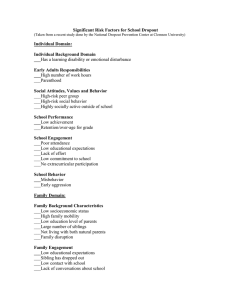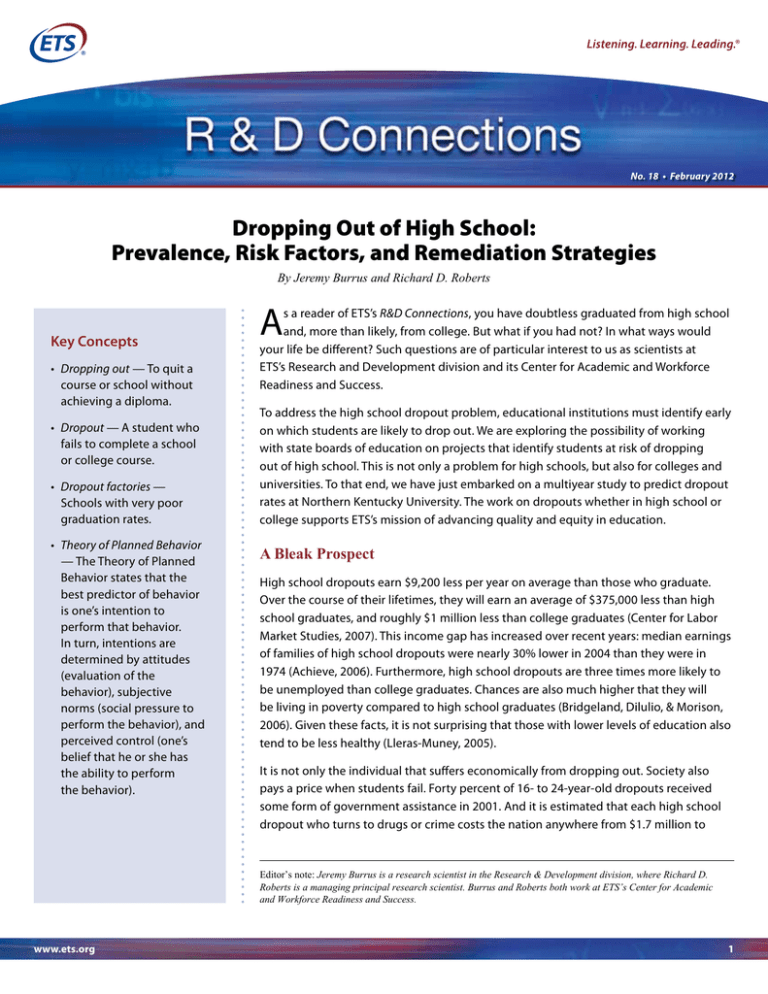
No. 18 • February 2012
Dropping Out of High School:
Prevalence, Risk Factors, and Remediation Strategies
By Jeremy Burrus and Richard D. Roberts
Key Concepts
• Dropping out — To quit a
course or school without
achieving a diploma.
• Dropout — A student who
fails to complete a school
or college course.
• Dropout factories —
Schools with very poor
graduation rates.
• Theory of Planned Behavior
— The Theory of Planned
Behavior states that the
best predictor of behavior
is one’s intention to
perform that behavior.
In turn, intentions are
determined by attitudes
(evaluation of the
behavior), subjective
norms (social pressure to
perform the behavior), and
perceived control (one’s
belief that he or she has
the ability to perform
the behavior).
A
s a reader of ETS’s R&D Connections, you have doubtless graduated from high school
and, more than likely, from college. But what if you had not? In what ways would
your life be different? Such questions are of particular interest to us as scientists at
ETS’s Research and Development division and its Center for Academic and Workforce
Readiness and Success.
To address the high school dropout problem, educational institutions must identify early
on which students are likely to drop out. We are exploring the possibility of working
with state boards of education on projects that identify students at risk of dropping
out of high school. This is not only a problem for high schools, but also for colleges and
universities. To that end, we have just embarked on a multiyear study to predict dropout
rates at Northern Kentucky University. The work on dropouts whether in high school or
college supports ETS’s mission of advancing quality and equity in education.
A Bleak Prospect
High school dropouts earn $9,200 less per year on average than those who graduate.
Over the course of their lifetimes, they will earn an average of $375,000 less than high
school graduates, and roughly $1 million less than college graduates (Center for Labor
Market Studies, 2007). This income gap has increased over recent years: median earnings
of families of high school dropouts were nearly 30% lower in 2004 than they were in
1974 (Achieve, 2006). Furthermore, high school dropouts are three times more likely to
be unemployed than college graduates. Chances are also much higher that they will
be living in poverty compared to high school graduates (Bridgeland, Dilulio, & Morison,
2006). Given these facts, it is not surprising that those with lower levels of education also
tend to be less healthy (Lleras-Muney, 2005).
It is not only the individual that suffers economically from dropping out. Society also
pays a price when students fail. Forty percent of 16- to 24-year-old dropouts received
some form of government assistance in 2001. And it is estimated that each high school
dropout who turns to drugs or crime costs the nation anywhere from $1.7 million to
Editor’s note: Jeremy Burrus is a research scientist in the Research & Development division, where Richard D.
Roberts is a managing principal research scientist. Burrus and Roberts both work at ETS’s Center for Academic
and Workforce Readiness and Success.
www.ets.org
1
R&D Connections • No. 18 • February 2012
“ETS can design assessments
that predict which students
are most at risk for dropping
out. Researchers have
identified several factors
related to dropping out of
school, and many of these
factors can be identified
early on in a student’s
school career.”
$2.3 million dollars over his or her lifespan (Bridgeland, 2006). High school dropouts
may — taken together — represent billions of dollars annually in lost revenue for
the U.S. economy (Achieve, 2006; Christenson & Thurlow, 2004).
As an educational assessment organization, ETS can design assessments that predict
which students are most at risk for dropping out. Researchers have, as shown below,
identified several factors related to dropping out of school, and many of these factors
can be identified early on in a student’s school career. ETS can support this field by
providing reliable assessments that measure these factors, thus helping educators
identify students in need of intervention while there is still time.
Changing Status Quo
It is our hope that our work will help change the dropout “status quo,” but let us begin by
reviewing the current state of affairs. How many young people drop out of high school?
For 2009, the National Center for Education Statistics (NCES) estimates that 8.2% of all
non-incarcerated 16- to 24-year olds in the United States were not enrolled in school and
had yet to earn a high school degree (Aud et al., 2011). That adds up to about 3.17 million
people. Furthermore, 40% of all incarcerated 16- to 24-year olds in the United States are
high school dropouts, adding an additional 205,000 people to this population. This figure
may need to be revised upwards as it does not include a group that NCES’s research may
not well represent — those whose immigration status is undocumented. If we add this
group to the total, the number of 16- to 24-year-old dropouts will probably exceed 4
million at any one time. The average graduation rate by state is depicted in Figure 1.
Figure 1. Average freshman graduation rate for public high school students, by state
or jurisdiction: School year 2007–08
Less than 70.0% (10)
70.0–79.9% (24)
80.0% or higher (17)
Source: U.S. Department of Education. Institute of Education Sciences, National Center for Education Statistics.
www.ets.org
2
R&D Connections • No. 18 • February 2012
“Seventy percent of the
participants in one study
‘were confident that they could
have graduated high school
if they had stayed in school,
and 66% said they would have
worked harder if their teachers
and parents had had higher
expectations of them.’”
The dropout numbers for ethnic minorities are considerably higher. In 2009, the
proportions of 16- to 24-year-old high school dropouts were 10.7% for African
Americans, 15.9% for American Indians, and 17.9% for Hispanics. This problem is
exacerbated in urban centers (Neild & Balfanz, 2006). Researchers estimate that as few
as 50% of African-American, American Indian, and Hispanic students graduate from
high school in some cities (Bridgeland et al., 2006).
These are dismal numbers, but we do have reasons to believe that they can be
improved. Some of the most compelling reasons for hope come from the dropouts
themselves. For instance, Bridgeland et al. (2006) conducted focus groups and face-toface interviews of a diverse set of 467 dropouts aged 16 to 25 in 25 locations across the
United States. Most interviewees believed that they had the ability to earn a high school
degree: 70% said they were confident that they could have graduated high school if
they had stayed in school, and 66% said they would have worked harder if their teachers
and parents had had higher expectations of them. One should take care in interpreting
these results, however, as this was not a nationally representative sample.
In addition, many respondents were aware of the importance of having a high school
diploma. Eighty-one percent of the people interviewed said that getting a high school
diploma was essential to their personal success. Furthermore, the great majority of
dropouts regretted dropping out: 74% said they would have stayed in school if they
could decide again. In addition, 76% of those who said they regretted their decision to
drop out said that they would return to school if that option existed for students in their
age group (Bridgeland et al., 2006).
These individuals are clearly not lost causes, and there is value in identifying students at
risk of dropping out. If we can reach these students before they drop out and intervene
to keep them in school, we can improve the future of both individual students and the
nation as a whole.
The Dropout Process
Dropping out is a process that begins well before high school, and students
exhibit identifiable warning signs at least one to three years before they drop out
(e.g., Allensworth, 2005; Neild & Balfanz, 2006; Roderick, 1994; Rumberger, 2004).
Furthermore, most students who drop out tend to do so relatively early in their high
school careers. One recent study found that most students who dropped out of the
Philadelphia public schools did so by the end of the 10th grade (Neild & Balfanz, 2006).
Although students in Pennsylvania do not have the legal right to drop out until they are
17 years old, these students are referred to as “undercredited,” meaning that they have
successfully completed relatively few courses compared to the number of years they
have spent in school. This means that they have dropped out for all practical purposes
even though they are not legally allowed to do it at that age. Furthermore, 70% of
Philadelphia students classified as “near dropouts,” or students who attend class less
than 50% of the time, were in the ninth or 10th grade. These students had a 45% chance
of dropping out if they had reached ninth grade, a 34% chance if they had reached tenth
grade, a 23% chance if they had reached eleventh grade, and a 16% chance if they had
reached twelfth grade (Neild & Balfanz, 2006).
www.ets.org
3
R&D Connections • No. 18 • February 2012
“Dropping out is a process
that begins well before high
school, and students exhibit
identifiable warning signs
at least one to three years
before they drop out (…)
Furthermore, most students
who drop out tend to do so
relatively early in their high
school careers.”
What are some of the early warning signs that a student may drop out? Below we
outline early indicators of student dropout risk. These include both demographic and
performance indicators. Later we outline some psychosocial factors — factors related to
personality and motivation — found to be associated with dropping out of high school.
Table 1 displays a summary of these factors.
Predictors of Dropout Risk: Early Warning Indicators
Students at risk for dropping out display certain easily identifiable characteristics, some
of which are demographic and some of which are related to their performance in school.
Table 1: Factors associated with dropping out of high school
Demographic Characteristics
Performance Characteristics
Comes from low-income family
Lack of credits earned
Male
Poor attendance
Members of racial or ethnic minority group
Poor grades (especially in core courses)
Older than the average student in their grade
Self-Identified Factors About Self
Self-Identified Factors About Others
Class not interesting
Adults did not expect them to perform in school
Lack of engagement with school
Parents not involved in education
Tests too difficult
Teachers did not seem interested in school
Poor attendance
Demographics. Demographic indicators of at-risk students include the following
(Allensworth, 2005; Roderick, 1994; Rumberger, 2004):
• Coming from a low-income family
• Being a member of a racial or ethnic minority group
• Being older than the average student in one’s grade
• Being male
Performance. Researchers have found performance indicators that can identify students
at risk of dropping out as early as eighth grade with a high degree of certainty. The
previously mentioned study of Philadelphia’s public schools found each of the following
factors measured in eighth graders to predict dropping out: low attendance, poor grades
in core courses, and being overage for one’s grade (Neild & Balfanz, 2006).
An eighth grade student had at least a 75% chance of dropping out if he or she:
a) attended school less than 80% of the time in eighth grade, and
b) failed mathematics and/or English during the eighth grade.
www.ets.org
4
R&D Connections • No. 18 • February 2012
This research categorized ninth grade students as “at risk” if they:
a) attended school less than 70% of the time in ninth grade,
b) earned fewer than two credits during the ninth grade, and
c) were not promoted to the 10th grade on time.
Overall, 80% of eighth and ninth grade students who were categorized as “at risk”
eventually dropped out of high school.
Other studies have found similar results. For example, in a study of students in Chicago’s
public schools, Allensworth (2005) created an indicator variable to designate whether
ninth-grade students were “on track” to graduate. Students were classified as not “on
track” if they had low numbers on at least two of the following risk factors: attendance,
grade point average, credits earned, and individual grades. This method of classifying the
students in Chicago’s public school system was 85% accurate in predicting high school
graduation (Allensworth, 2005).
Another example comes from an investigation of a small school district in Massachusetts,
where students with the largest drop in performance during the transition from
elementary school to middle school, and from middle school to high school, were most
likely to drop out (Roderick, 1994). This result further reinforces the conclusion of the
study of Philadelphia students that students at risk for dropping out can be identified at,
or prior to, the beginning of high school.
Predictors of Dropout Risk: Psychosocial Factors
Other predictors of dropping out of high school may be characterized as psychosocial
factors, or factors related to personality and motivation. For example, it is possible
to use the extent to which students — and their parents and teachers — actively
engage in the educational process to predict how likely the students are to graduate.
Engagement is multifaceted and includes the level of identification with the school and
the development of positive relationships with peers and teachers. Forty-seven percent
of participants in the Bridgeland et al. (2006) focus-group study said that they did not
find school interesting, and that this was a factor in their decision to drop out. Such lack
of engagement may not be limited to the students. Many of them doubted that their
teachers were interested in school or student learning, and felt that they were more
concerned with completing their workday than teaching class.
This lack of adult engagement is a recurring theme in research done by Bridgeland et
al. In a 2006 study, 69% of the dropouts claimed that adults did not expect them to
perform well, and that these low expectations contributed to their decision to drop
out. Moreover, these students’ feelings seem to be accurate. In a follow-up study that
involved interviews with teachers, Bridgeland, Dilulio, and Balfanz (2009) found that only
32% of surveyed high school teachers agreed with the statement, “We should expect
all students to meet high academic standards and provide extra support to struggling
students to help them meet those standards” (p. 22). Empirical research has in fact
demonstrated that teacher expectations do indeed affect both grades and students’
likelihood of dropping out (Kaufman, Bradbury, & Owings, 1992).
www.ets.org
5
R&D Connections • No. 18 • February 2012
“In a 2006 study, 69% of
the dropouts claimed that
adults did not expect them to
perform well, and that these
low expectations contributed
to their decision to drop out.”
Many participants in the Bridgeland et al. study (2006) also said that they felt
insufficiently challenged by their teachers and that classes were not motivating. Most
participants in the survey responded that expectations to complete homework were
very low: 80% said they completed one hour or less per day, while 26% said they
completed no homework. Higher parent and teacher expectations could have increased
the likelihood that they would have graduated. As stated earlier, 66% of participants
claimed that they would have worked harder in high school if more had been asked
of them. Research does however suggest that few teachers would have done that. In
the Bridgeland et al. (2009) follow-up study, 76% of the teachers placed most of the
responsibility for the dropout problem on the students; only 13% said that teachers
were responsible.
Parental involvement in a student’s education plays an important role for his or her
success in school (White & Kelly, 2010). Several dropouts in the Bridgeland et al. (2006)
study indicated that their parents were not engaged in their education, or had become
involved too late to make a difference. Twenty-one percent of the participants said that
their parents were “not at all aware” and 51% of participants said that their parents were
“just somewhat aware” of their school attendance and grades. Furthermore, 28% said
that their parents were “not at all aware” that the student was on the verge of dropping
out, and 50% of participants said that their parents were “just somewhat aware” of this
fact (Bridgeland et al., 2006).
We see a need for more study of attitudes as a psychosocial factor that predicts drop out.
Specifically, the Theory of Planned Behavior (TPB) — a psychological theory that includes
the role of attitudes — holds promise in predicting drop out. Briefly, the theory says that
intentions are the best predictor of behavior and that intentions are predicted by:
• A
ttitudes, meaning a person’s evaluation of his or her own behavior or of
others’ behaviors;
• S ubjective norms, which refers to the social pressure one feels to perform the
behavior; and
• P
erceived control, meaning a person’s perception of his or her own capability to
perform the behavior.
Thus far, only one study has used this theory to predict high school drop out, and it
did so with great success (Davis, Ajzen, Saunders, & Williams, 2002). In this study, innercity high school sophomores completed a short questionnaire that assessed each of
the components of the TPB. The authors then predicted whether the students would
graduate from high school three years later. Results revealed that the participants’
responses as sophomores significantly predicted whether they eventually graduated or
dropped out.
“Dropout Factories”
There is a subgroup of high schools in the United States where the annual graduation
level is at best 50% (Balfanz & Letgers, 2004), making them de facto “dropout factories.”
About 15% of all high schools in the United States belong to this category, and half of all
www.ets.org
6
R&D Connections • No. 18 • February 2012
“The higher the percentage
of a school’s students living
in poverty, the higher the
dropout rate. Poverty seems
to be one of the strongest, if
not the strongest, predictor of
a school’s dropout rate.”
dropouts in the country are “produced” by these schools. A very large portion of
all minority student dropouts come from such dropout factories; about 50% of the
African-American and 40% of the Hispanic students in the United States attend them.
Most of these schools are located in the country’s largest cities, or in the rural south
and southwest.
What do these schools have in common?
Poverty.
Balfanz and Letgers found a strong relationship between poverty and the dropout
rate: The higher the percentage of a school’s students living in poverty, the higher the
dropout rate. Poverty seems to be one of the strongest, if not the strongest, predictor of
a school’s dropout rate. This is underscored by the fact that minority students graduate
at the same rate as white students when attending schools in low-poverty areas.
Can We Reduce the Dropout Rate?
The research discussed here on predicting high school dropouts would be nearly
inconsequential unless something could be done about it. Fortunately, we see reason for
optimism that graduation rates can indeed be improved. But two things are needed for
this change to happen.
1. T o keep students from dropping out, we need to know which students are most at
risk. It should be clear by now that we have the ability to identify the students who are
most likely to drop out. We can also identify high schools with extremely high dropout
rates. This means that we can intervene both at the individual student level, and at the
school or district level.
2. W
e need effective intervention programs. Many dropout intervention programs have
been developed, but we do not know which of them would have the best effect on
dropout rates. Some do hold promise, however. The What Works Clearinghouse at
the Institute for Education Sciences (IES) evaluates educational interventions, and it
has evaluated 28 dropout prevention programs. Given space limitations, we will not
discuss individual intervention programs, but invite interested readers to learn more
about these programs by visiting the IES website.1 Of the 28 dropout prevention
programs described on the IES website, 13 have demonstrated some “evidence
of positive or potentially positive effects for at least one improvement outcome,”
meaning that they have demonstrated some effectiveness in helping students to
stay in school or show improvement in school. Of these 13, however, only five have
demonstrated “potentially positive” effects in helping students to complete school.
This is not to say that the other eight programs do not help students to complete
school; however, there is no evidence to date that they do. The main point is that,
although some programs appear promising, more research is needed. Clearly, though,
some programs seem to be on the right track.
1
www.ets.org
http://ies.ed.gov/ncee/wwc/reports/topicarea.aspx?tid=06
7
R&D Connections • No. 18 • February 2012
Concluding Comments
There is no denying that student dropout rates are a major social and economic problem
in the United States. Too many students leave high school without graduating. This is
costly not only for the individual, but also for the entire society.
The narrative surrounding the dropout problem is often one of doom and gloom, but
we would like to finish by offering a more positive perspective. While it is clear that the
United States desperately needs to improve high school graduation rates, it is a possible
task if our citizens and policymakers demonstrate the will to do it. We do know how
to identify the great majority of students on track to drop out, and we can identify the
schools that are most likely to produce dropouts. In addition, researchers and educators
are developing promising interventions that can help these students.
The good news is that we as a nation can ameliorate the dropout problem, if only we can
mobilize the necessary resolve.
References
Achieve, Inc. (2006). Identifying potential dropouts: Key lessons for building an early warning
data system. Retrieved from http://www.achieve.org/files/FINAL-dropouts_0.pdf.
Allensworth, E. (2005). Graduation and Dropout Trends in Chicago: A look at cohorts
of students from 1991 through 2004. Chicago: Consortium on Chicago
School Research.
Aud, S., Hussar, W., Kena, G., Bianco, K., Frohlich, L., Kemp, J., & Tahan, K. (2011). The
Condition of Education 2011 (NCES 2011-033). U.S. Department of Education,
National Center for Education Statistics. Washington, DC: U.S. Government
Printing Office.
Balfanz , R., & Letgers, N. (2004). Locating the dropout crisis: Which High Schools Produce
the Nation’s Dropouts? Where Are They Located? Who Attends Them? Center for
Social Organization of Schools, Johns Hopkins University.
Bridgeland, J. M., Dilulio, J. J., & Balfanz, R. (2009). On the Front Lines of Schools:
Perspectives of Teachers and Principals on the High School Dropout Problem.
Retrieved from http://www.civicenterprises.net/pdfs/frontlines.pdf.
Bridgeland, J. M., Dilulio, J. J., & Morison K. B. (2006). The Silent Epidemic: Perspectives of
High School Dropouts. Retrieved from http://www.civicenterprises.net/pdfs/
thesilentepidemic3-06.pdf.
Center for Labor Market Studies (2007). Left behind in America: The nation’s dropout
crisis. Retrieved from http://chicagowritingservice.com/content/wpcontent/
uploads/2008/09/clmsexecreport2.pdf.
Christenson, S. L., & Thurlow, M. L. (2004). School dropouts: Prevention considerations,
interventions, and challenges. Current Directions in Psychological Science, 13,
36–39.
www.ets.org
8
R&D Connections • No. 18 • February 2012
Davis, L. E., Ajzen, I., Saunders, J., & Williams, T. (2002). The decision of African American
students to complete high school: An application of the Theory of Planned
Behavior. Journal of Educational Psychology, 94, 810–819.
Kaufman, P., Bradbury, D., & Owings, J. (1992). Characteristics of At-Risk Students.
Published in NELS:88. Washington, DC: National Center for Education Statistics.
Lehr, C. A., Hanson, A., Sinclair, M. F., & Christenson, S. L. (2003). Moving beyond dropout
prevention towards school completion: An integrative review of data-based
interventions. School Psychology Review, 32, 342–364.
Lleras-Muney, A. (2005). The relationship between education and adult mortality in the
United States. Review of Economic Studies, 72, 189–221.
Neild, R. C., & Balfanz, R. (2006). Unfulfilled promise: The dimensions and characteristics of
Philadelphia’s dropout crisis, 2000–2005. Retrieved from http://www.csos.jhu.edu/
new/Neild_Balfanz_06.pdf.
R&D Connections is published by
ETS Research & Development
Educational Testing Service
Rosedale Road, 19-T
Princeton, NJ 08541-0001
email: RDWeb@ets.org
Editors: Hans Sandberg and
Jeff Johnson
Copy Editor: Eileen Kerrigan
Layout Design: Sally Acquaviva
Visit ETS Research &
Development on the web
at www.ets.org/research
Follow ETS Research on Twitter
(@ETSresearch)
Copyright © 2012 by Educational Testing Service.
All rights reserved. ETS, the ETS logo and LISTENING.
LEARNING. LEADING. are registered trademarks of
Educational Testing Service (ETS). 18852
Roderick, M. (1994). Grade retention and school dropout: Investigating the association.
American Education Research Journal, 31, 729–759.
Rumberger, R. W. (2004). Why students drop out of school. In Orfield, G. (Ed.), Dropouts in
America: Confronting the Graduation Rate Crisis (pp. 131–156). Cambridge, MA:
Harvard Education Press.
White, S. W., & Kelly, F. D. (2010). The school counselor’s role in school dropout
prevention. Journal of Counseling & Development, 88, 227–235.

